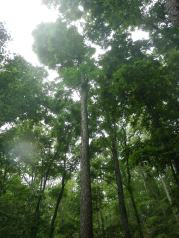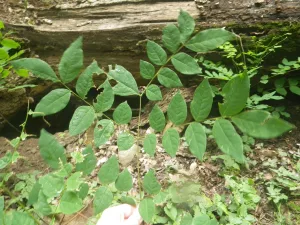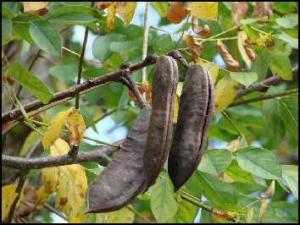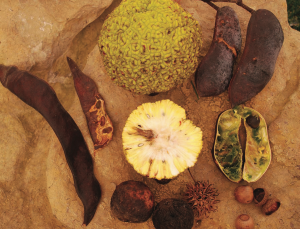Anachronism: a person or thing that is chronologically out of place; especially: one from a former age that is incongruous in the present (Merriam-Webster).


Sometimes, the most exciting plants to find are the misfits- the ones that simply don’t belong in the places they’re found. Last Wednesday while surveying below the bluff near King Farm, Dr. Jon Evans discovered one such misfit: the Kentucky Coffeetree (Gymnocladus dioicus), a new and mysterious addition to the flora of the Domain and of Franklin County. This leguminous tree is most often found in small clumps ranging from New York and Pennsylvania west to Minnesota, south to Oklahoma, and east to Kentucky and western Tennessee, yet it is becoming less and less common throughout its range. Why? Because the Kentucky Coffeetree is an ecological anachronism, a species lost in time.
Before going any further, let us take note of the scientific name of this tree (which tells us a great deal about its life history): Gymnocladus, “naked branch,” refers to the tree’s habit of putting on leaves long after most other trees have leafed out, then being one of the first to drop its leaves in the early fall. For about six months of the year, the Kentucky Coffeetree is ‘naked.’ The species name dioicus indicates that the tree is dioecious, that is, it has distinct male and female individuals and there must be interaction between the two sexes for fertilization to occur (humans are also dioecious).
It would be difficult to identify G. dioicus when it is naked, but we found it fully leafed out (as is typical for July). The foliage (alternate, bipinnately compound, ovate leaves) gave its identity away to Evans, who recalled his first encounters with the tree in his grandmother’s yard. The other tell-tale sign of a coffeetree would be its fruit: large, flat pods 15-20 cm long and 3-5 cm wide, dark reddish-brown in color, ripening in autumn and persisting on the tree until late winter or early spring. Each pod contains four to eight seeds, which, when roasted, produce a suitable coffee substitute (hence the common name, “coffeetree”). A quick search of the leaf litter surrounding our grove of coffeetrees revealed no fallen pods, no seeds. You see, the Kentucky coffeetree is having a tough time with sexual reproduction these days, and it’s not just a temporary rut. The primary way it survives today is through its ability to reproduce clonally by sending out runners. Since we found no evidence of pods (which would indicate sexual reproduction) we have reason to believe that our clump of trees is actually only one genetic individual, stranded from individuals of the opposite sex and thus evolutionarily defunct. 
So, why is the Kentucky coffeetree on the decline across its range? Because it’s not going anywhere. The animals that once moved its seeds from place to place are now lost to this world, extinct. There’s no chance that our tiny population will come into contact with other trees of the opposite sex, so there’s no chance of it producing new genetic individuals. It is, essentially, a relic, destined to fade into extinction.
The Kentucky coffeetree isn’t alone; a number of other species (the osage orange, pawpaw, persimmon, and honey locust, to name a few) are also suspected to have coevolved with the extinct group of animals known as the Pleistocene megafauna. A quick glance at the fruit of some of these species should be enough to explain the now-failed relationship: to be desirable to megafauna, you need mega-fruits! Sadly, the hefty herbivores (ground sloths, camelids, horses, mastodons, and more) that once dominated the North American ecosystem went extinct in the Holocene epoch (around 12,000 years ago), leaving stranded the big-fruited trees that depend upon big-mouthed critters for seed dispersal. In the blink of an eye, specialized traits that took millions of years to evolve became obsolete. Though it is uncertain which member of the megafauna once dined on the Kentucky coffeetree’s giant seed pods, it’s clear that the pods have no place in today’s forests. Even if some clever squirrel found a way to open one, the toxic pulp inside would kill it shortly afterward. The tree is a true anachronism, a ghost of the forests of old.
So, if there’s nothing moving the seeds of G. dioicus, what is it doing on the Domain, far from its native range? Herein lays the mystery of this misfit. There are a few possibilities. One, that the trees we saw were actual remnants from the Pleistocene, a vestigial population that was once part of a much larger, contiguous range. The Domain’s population marks the easternmost occurrence of the species in Tennessee, yet it is possible that coffeetrees once grew across the state. The second possibility is that humans (perhaps Native Americans, who drank a brew of the roasted seeds) transported the seeds and intentionally planted them along the benches of the Cumberland Plateau, where a variety of other plants were prehistorically cultivated for food and medicine. Regardless of how it arrived here, we can be sure that the Kentucky coffeetree isn’t going to be doing much travelling in the future, save for the few meters of extension it may achieve through its root system.
Ecological anachronisms like G. dioicus raise some very interesting questions about the past, present, and future of our flora. How can we understand our present assemblage of biodiversity without putting it in the context of the distant past (which is not-so-distant at all in evolutionary terms)? How many North American floral-faunal interactions have been lost or destroyed since European contact? Can species in their demise (like the coffeetree) inform us on how to manage species that are on the brink? How many more misfits are out there on the Domain waiting to be discovered?


In my dendrology class at MTSU I was introduced to an interesting individual of this species. Dr.
Blum told the class that the species is polygamodioecious. The big tree on the MTSU campus
had male and female flowers in the spring and was loaded with fruit when we saw it in the fall. I harvested a few seeds. After I filed a notch down to the endosperm I soaked the seeds overnight in water. Every seed germinated and I grew them in pots and later selected one to plant in the ground. Recently, I had to move the tree from its original location. In about 28 years it had grown over 15 feet high under some sugar maples. I root pruned it in late summer and the next spring I pruned the top and proceeded to dig it out of the ground. The root pruning had the desired effect of producing small feeder roots. Unexpectedly, this process also produced shoots on the other side of a few cut roots. I had one large transplant and two small ones. These are now in my yard and have been enjoying the generous rains of 2013. Anthropochory in action.
Todd- how neat! If only the Domain had a polygamous individual; I’d love to see the fruits and seeds. Glad to hear your trees are doing well!
From my experience, I’ve found Kentucky Coffee Trees to be in clumps in areas that have been flooded. Was water a factor in the site where this tree was found? Can you go down hill or downstream and see if you find more?
As for pawpaws and persimmons, I have found lots of these trees on the domain and it is a race to get to the fruit before the animals do. Though the megafauna probably enjoyed eating these fruits, the recent fauna enjoy them just as much. Like apples, pawpaw and persimmon do not grow “true” from seed and a tree raised from seed will produce fruit of varied taste, color, texture, etc. That’s why many horticulturalists will graft varieties worthy of cultivation. Given this idea that seedling trees don’t produce uniform fruit characteristics, could they still be here due to animals selecting for smaller fruit? Just a thought…
The area where we found this population isn’t particularly wet, nor is it close to a stream of any mentionable size, however, the population probably still gets plenty of water from seeps/runoff from the bluff above. The next time we go out to take a look, we’ll be sure to trek further downhill in search of more!
As for pawpaws and persimmons, I was unaware that they share that interesting trait with apples (Michael Pollan’s A Botany of Desire goes into great detail about this- fascinating!). Perhaps that approach has allowed them to persist and evolve a more palatable fruit for this new age of smaller animals. In any case, they won’t go extinct as long as humans are around- persimmons are much too tasty!
Can you make coffee from it?
Early settlers were said to have used the seeds to make “a poor coffee substitute,” so it probably wasn’t as good as the real thing, but yes! Coffee can be made from the seeds AFTER roasting them (if eaten raw they are toxic).
Fascinating! Are there any signs of settler homesteads in the area?
Good question! This site was almost directly downslope from the King Farm, but we think it was much too far down (several benches down) to be able to attribute the occurrence of these trees to accidental dispersal from the farm. The site was definitely disturbed in some way, with noticeably fewer old trees than the surrounding areas, yet we found no signs that would indicate prior human occupation. A fresh landslide along the same bench and close to the KY Coffeetree site turned us on to the idea that the disturbance may have been geological, not anthropological.
For an effective nutrient distribution network you might need megafauna.
https://theconversation.com/megafauna-extinction-affects-ecosystems-12-000-years-later-16977
We live in the UK and planted our Kentucky Coffee Tree about thirty years ago. For the first time ever this it has no leaves does anyone know if it will come back next year? We have had very wet spring/summers over the last 3/4 years.